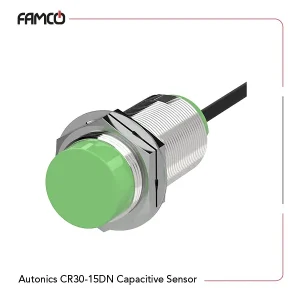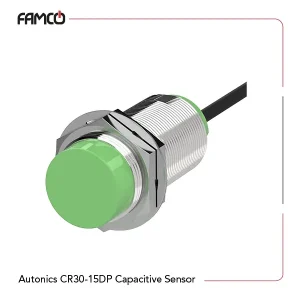Autonics’ capacitive proximity sensors, such as the autonics capacitive proximity sensor, provide high degrees of accuracy and versatility across several sectors.
Click here for more particular specs, designs, and costs. Industrial sensing technologies are still developing, and Autonics is leading the way with creative but useful solutions. Let’s examine what is capacitive sensor and how it works, and why Autonics is unique in the industry.
All types of Autonics Capacitive Sensor
A range of capacitive sensors from Autonics are available to meet various industrial requirements. These sensors use a non-contact technique to detect materials that are either conductive or non-conductive. A variety of models, such as those intended for material identification, liquid level sensing, and proximity detection, are available for Autonics Capacitive Sensors.
Capacitive Cylindrical Proximity Sensors
The cylindrical capacitive proximity sensor is one of the most often used varieties of Autonics capacitive sensors. These sensors are commonly employed in sectors where it is crucial to precisely identify materials such as liquids, powders, and polymers. Their cylindrical form contributes to their attractiveness in industrial applications by making installation simple in cramped locations.
Features of Autonics Capacitive Sensor
Cylindrical Design
Autonics capacitive sensors’ cylindrical shape makes it simple to install them in confined or complicated areas. They may be used in a variety of settings, such as assembly lines and industrial facilities, thanks to their very adaptable architecture.
Material Detection
Among the materials that Autonics capacitive sensors can detect are liquids, solids, powders, and even granules. They may be used for a variety of tasks, including as automation and quality control, because of their adaptability.
Sensitivity Adjustment
The sensitivity of Autonics capacitive sensors may be adjusted, which is a noteworthy feature. This enables users to adjust the sensor’s functionality according to the substance it is detecting. Sensitivity adjustment is essential in high-precision conditions as it guarantees optimum performance and minimizes the possibility of erroneous triggering.
Benefits of autonics capacitive sensor
Versatile Detection
The ability of Autonics capacitive sensors to detect both conductive and non-conductive materials is a significant advantage. Their capacity to recognize plastic bottles on an assembly line and monitor liquid levels in a tank enable them to operate efficiently in a variety of industrial settings.
High Sensitivity
Autonics capacitive sensors are perfect for precise applications because of their great sensitivity, which allows them to pick up on even the smallest changes in their surroundings. This capability is especially helpful in areas like packaging and pharmaceuticals where precision is crucial.
Non-Contact Sensing
Non-contact sensing is an additional noteworthy benefit. Wear and tear are reduced as the sensor does not come into contact with the substance it detects. This increases the lifetime of the sensor and guarantees that maintenance expenses will stay low over time.
Problems of autonics capacitive sensor
False Triggering
Capacitive sensors often experience false triggering, particularly in high electromagnetic interference (EMI) situations. Even while Autonics sensors have sensitivity modifications to help reduce this, there are still certain high-EMI conditions where false triggering may happen.
Sensitivity Issues
While the sensitivity of Autonics capacitive sensors may be adjusted, sensitivity problems may arise from incorrect calibration. This may result in the sensor missing a target or triggering when unintended things are present in the vicinity of the target.
Contamination
The sensitivity of capacitive sensors to external contaminants, including dust or moisture, is one of the possible disadvantages of employing them. Inaccurate readings or even sensor failure may result from contamination or debris on the sensor surface.
Applications of Autonics Capacitive Sensor
Manufacturing
On of the capacitive sensor uses is in the industrial industry. Autonics capacitive sensors are often used to detect items on conveyor belts and to keep an eye on the liquid levels in storage tanks. They are quite useful here since they can identify both conductive and non-conductive materials.
Packaging
Autonics capacitive sensors are often used in the packaging sector to check that packaging is properly sealed or to detect the presence of goods in containers. Their heightened sensitivity guarantees accurate detection of even the smallest items.
Automotive
Autonics capacitive sensors are essential to automated assembly lines in the automobile sector. They are used to keep an eye on fluid levels, look for the existence of auto components, and guarantee correct alignment throughout assembly.
Textile Industry
Capacitive sensors are used by the textile industry to track the existence of threads and textiles on manufacturing lines. Autonics sensors monitor the presence and location of the fabric during processing, ensuring that the machines run smoothly.
Autonics Capacitive Sensor Price
Depending on the particular model and functionality, Autonics capacitive sensors available at a variety of price points. For instance, the Autonics CT6S-1P2 provides outstanding value considering its sophisticated detecting capabilities. Size, sensitivity, and extra features all affect price, however Autonics sensors are usually seen to be more reasonably priced when compared to other comparable goods on the market.
You may visit the manufacturer’s website or authorized distributors for more detailed price information about capacitive sensor circuit, including bulk purchase discounts and shipping choices.




